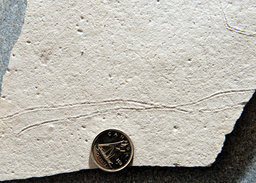University of Alberta scientists say they’ve proven animal life existed 30 million years earlier than previously known.
Geologists Ernesto Pecoits and Natalie Aubet found fossilized tracks in Uruguay they believe was left behind by a slug-like creature at least 585 million years ago.
Kurt Konhauser, a geomicrobiologist at the university, co-authored the study published Thursday in the journal Science.
He said the fossils have been dated between 600 million and 585 million years old. The next oldest fossil showing evidence of moving life — found in Russia — is dated at 555 million years.
“Essentially, we’ve got the earliest evidence for an animal that can move, from which we eventually evolved,” Konhauser said.
“We’ve pushed the date back 30 million years in just one fell swoop.”

Fossilized tracks left by a small creature known as a bilaterian, discovered by U of A scientists in Uruguay
“We found something that showed pretty advanced behaviour. So we know that earlier than 600 (million years) we must have still had animals,” Konhauser said.The creature that left the tracks in silty sediment is known as a bilaterian and was only a few millimeters long, he said, but its tracks suggest it had primitive feet and was able to pull itself forward. He said the oldest known animals are sponges, which could not move.
The U of A team discovered the fossils by chance in 2007 after two years of extensively mapping the area.
The sedimentary rock containing the fossil happened to be cross-cut by granite, which contains a mineral called zircon that allowed the specimen to be dated. The dating process took four years using “all sorts of state-of-the-art techniques that the University of Alberta happens to have,” Konhauser said.
“To be lucky enough to not only have the thing preserved but then to find that relationship (with the granite), took a long time. It wasn’t until we found that relationship that we could unequivocally demonstrate that they were that age,” he said.
“There was no dispute that these things were primitive animals, but the question was the age.”
He said the finding is another step toward confirming theoretical estimates that the earliest animal life on Earth came 630 million to 700 million years ago.
“We’ve actually got physical evidence that corroborates with what these theoretical estimates were,” he said.



 June 29th, 2012
June 29th, 2012  riffin
riffin  Posted in
Posted in  Tags:
Tags: 